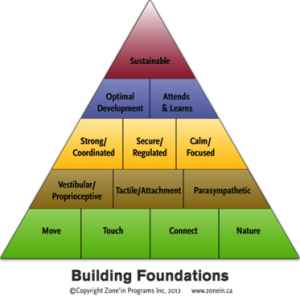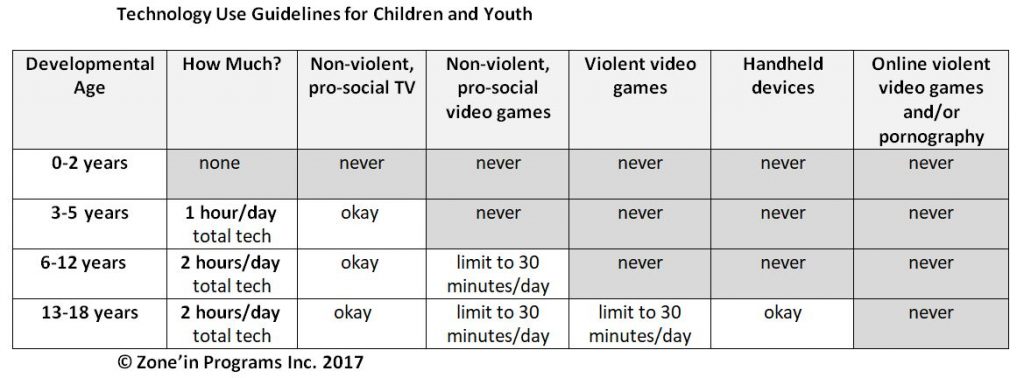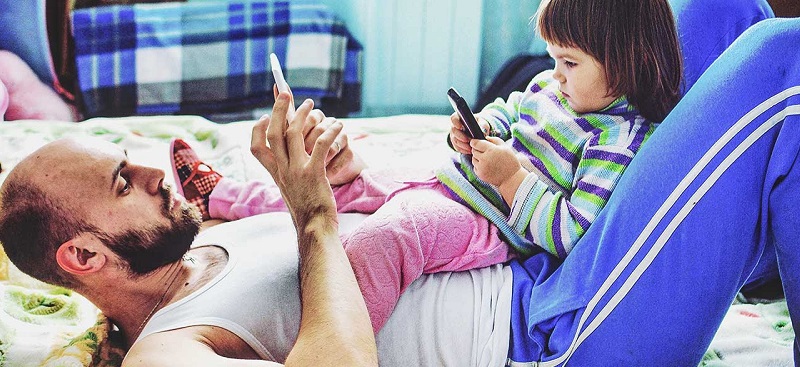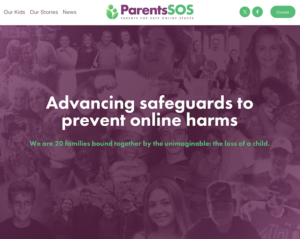 Following a recent media interview on the negative impact of technology on children, the reporter stated that she “felt guilty” about letting her children use so much technology. As I thought about how to respond, I became aware of my own desire to dismiss or alternatively, to validate her guilt. I wanted to help this Mom to feel better, but in dismissing her shame, I realized I was perpetuating a pervasive and immobilizing condition – Tech Guilt. Parents who perpetually feel guilty about their own (and their children’s) technology overuse, are essentially disabling themselves from moving forward toward better technology management practices. So if Tech Guilt is truly a useless and unproductive emotion resulting in ‘inaction’, why do parents do it so much? It’s almost as if feeling guilty about tech overuse is enough, that it somehow releases parents from taking actionable and productive steps toward tech reduction. Tech Guilt essentially provides parents with a temporary ‘relief’ in the unending saga of escalating child tech overuse, or does it? This article intends to explore the origins of Tech Guilt in parents, and proposes ten progressive steps toward moving beyond Tech Guilt toward actions that will ensure sustainable futures for all children.
Following a recent media interview on the negative impact of technology on children, the reporter stated that she “felt guilty” about letting her children use so much technology. As I thought about how to respond, I became aware of my own desire to dismiss or alternatively, to validate her guilt. I wanted to help this Mom to feel better, but in dismissing her shame, I realized I was perpetuating a pervasive and immobilizing condition – Tech Guilt. Parents who perpetually feel guilty about their own (and their children’s) technology overuse, are essentially disabling themselves from moving forward toward better technology management practices. So if Tech Guilt is truly a useless and unproductive emotion resulting in ‘inaction’, why do parents do it so much? It’s almost as if feeling guilty about tech overuse is enough, that it somehow releases parents from taking actionable and productive steps toward tech reduction. Tech Guilt essentially provides parents with a temporary ‘relief’ in the unending saga of escalating child tech overuse, or does it? This article intends to explore the origins of Tech Guilt in parents, and proposes ten progressive steps toward moving beyond Tech Guilt toward actions that will ensure sustainable futures for all children.
Research knowledge about the negative effects of technology in children is prolific, but yet not well known or accepted amongst parents, as well as many teachers and health professionals. I believe the salient reason for adult refusal to accept the fact that screens harm children, is their perceived inability to do anything about it. So they feel guilty for awhile, and self-treat that guilt with using more tech in an effort to forget, if only for awhile, the irreparable damage these devices are doing to their children. Ten Steps to reduce use of tech. Parents who know screens are harmful but continue to allow their children to overuse, report they resist Tech Guilt by telling themselves “I’ll deal with screen overuse later”, “It’s probably not that bad”, “I let my kids use screens because I need time for myself!” and even “My child’s problem behavior doesn’t have anything to do with screens, they must have a mental illness”. These thoughts act as pacifiers, and actively prevent parents from taking steps toward increasing engagement in healthy activities which would replace tech.
So how to move beyond Tech Guilt toward actionable steps to manage balance between technology and healthy activities? The following “Ten Steps to Unplug Your Family from Technology” will enable parents, teachers and health professionals to get on a healthy track, and create sustainable futures for children. Check out the new Tech Talks for Families 10 series webinars, and Tech Talks for Therapists 5 series webinars, to learn how to manage balance between healthy activities and technology including a three-day family unplug!
- BECOME INFORMED regarding the effects of technology on child development and learning.
Technology overuse is causality associated with child attention problems, poor academics, aggression, family conflict, impaired sleep, developmental delays, attachment disorders, depression, anxiety, impaired body image, obesity and early sexuality. The signs of technology addiction are increasing tolerance, withdrawal symptoms, unintended use, persistent desire, extended usage, displacement of other activities, and continued use when want to stop. The American Academy of Pediatrics recommends no more than one to two hours per day of combined technology use, yet elementary children use on average eight hours per day.
Need Help? Get informed by checking out the Zone’in website and watch the Suffer the Child and Reality Check videos, review the research on the Fact Sheet, read articles and comment on the Moving to Learn blog, sign up for the free Zone’in Child Development Series Newsletter, or order Cris Rowan’s book Virtual Child – The terrifying truth about what technology is doing to children.
- DISCONNECT YOURSELF and be available for your children.
As child technology use patterns that of their parents, technology addicted children are likely to live in a high technology usage household. Parents need to determine how much technology is too much, and set limits. Parents should then model balancing technology use with other activities. Schools could sponsor a Tech Unplug week where classrooms compete to reduce technology use in home and school, or have one day per week with NO TECH.
Need help? The Zone’in Mixed Signals workshop and webinar on technology balance offers the participants research based information regarding school, family, and community Balanced technology management strategies. This workshop/webinar comes with the complimentary Tech Tool Kit complete with screens, questionnaires, schedules, and a variety of strategies to help reduce the use of technology.
- RECONNECT by designating “sacred time” with each other.
The underlying causal factor for addiction is fear of human connection or “social anxiety”, and results from poor parent/child attachment formation. Parents and teachers might benefit from exploring past experiences of attachment with their own parents, and think about how this experience may have affected how they relate to their own child or students. Designation of “sacred time” in the day with no technology (meals, in the car, before bedtime, and holidays) is a first start toward reconnecting with your children.
Need help? Zone’in A Cracked Foundation workshop/webinar on attachment and addictions offers participants information regarding parent/child attachment and addictions, and profiles Attachment and Addiction Questionnaires.
- EXPLORE ALTERNATIVES to technology.
Not all children are interested in or value the same activities as adults. Fostering a tolerance for differences and respecting individual preferences can go a long way toward promoting children’s motivation to unplug.
Need Help? Have each family member make a list of ten realistic, inexpensive things to do by themselves, with a friend, with another family member, with a pet, indoors, and outdoors. Help children create a game, song, joke, poem, story or dance. Buy a book of games, create a story night, play wrestle, make up a play, build a fort of couch cushions, or family cooking night are but a few of a myriad of alternatives to technology use found in the Tech Tool Kit.
- ENHANCE SKILLS prior to unplugging your family.
Children with technology addictions have poorly developed skills in other areas. Self-identity, social skill, relationship to nature, and sense of spirit, are often disconnected in children who overuse tech. Drastic or sudden reduction in technology with a child who has an addiction, will result in chaos at school and home, as the child is now alienated from what has become their whole meaning for living. Help build performance skills by exposing children to alternate activities that are “just right challenge”, not too hard, not too easy, to build skill.
Need help? Zone’in offers the new Unplug’in Game for school and home settings, a developmental tool to build performance skills and confidence prior to a tech unplug.
- ENHANCE DEVELOPMENT AND LEARNING through engagement in the four critical factors for child development – movement, touch, human connection, and nature.

Children need to rough and tumble play 2-3 hours per day and spend time connecting with their parents, teachers and other children, in order to achieve optimal physical and mental health. Rough and tumble play promotes adequate sensory and motor development of the vestibular, proprioceptive, tactile and attachment systems needed for achieving literacy in printing, reading and math, as well as paying attention and learning.
Need help? Zone’in Harnessing Energy workshop/webinar and accompanying Zone’in Program offer participants information regarding sensory and motor development.
- ADDRESS PERCEPTIONS OF SAFETY – Go Outside! Go Green!
Parents’ perceptions of safety correlate with child time indoors in front of TV, internet, tablets, and video games e.g. if a parent perceives the world as unsafe, that child will spend more time indoors using technology. Fear of litigation in schools and communities, has drastically changed playgrounds, making them boring and unchallenging for most children. Outdoor rough and tumble play is a biological need for children, and has been proven to significantly reduce problematic behaviors, aggression, and attention deficit, as well as improve depression and anxiety.
Need help? Zone’in Why Children Can’t Sit Still workshop/webinar offers participants the Nature Directive and Playground Design handouts to enhance attention restoration through increasing access to nature, and enhance development through creating “sensational” playgrounds.
- CREATE INDIVIDUAL ROLES and foster independence.
50 years ago, children had family jobs and chores that if were not performed, threatened the very sustainability of the family. While life was tough, children had a strong sense of who they were, and their purpose in the family. Children benefit from knowing their role in the big picture, and self-esteem comes from being independently productive. Realistic challenges and expectations by parents and teachers promote defined roles for children, and provide a structure where they can begin to try out new skills. When faced with a task that is perceived to be beyond a child’s skill level, frustration and poor self-esteem will be the result.
Need Help? Zone’in Foundation Series Workshops/Webinars offers participants the Child Inner Drive Directive for Schools and Homes – or – purchase the new Unplug’in Game to establish self-identity, roles, and a sense of purpose in life.
- SCHEDULE BALANCE between technology use and activities.
Follow the Zone’in Concept of an hour of ‘energy in’ (technology use) equals an hour of ‘energy out’ (movement, touch, connection, and nature). Make up a weekly schedule with designated time for technology balanced with time for healthy activity. When beginning the Tech Unplug, it’s important to alternate between familiar, predictable, structured activities and novel activities. The parent and teacher’s job is to skillfully dance the child between predictability and novelty during the initial unplug period. Children can’t do what they haven’t been taught, so need to teach children how to explore new activities, while providing predictable structure and consistency.
Need Help? Zone’in Programs Inc. offers parents, teachers and therapists’ products, workshops, consultation and training to help address child technology addictions. See www.zonein.ca for more unplug information and suggestions, or purchase the Zone’in Tech Tool Kit for help..
- LINK CORPORATIONS TO COMMUNITY to create sustainable futures for children!
Zone’in Programs Inc. offers an invitation to all corporations involved in technology production, to re-direct a percentage of their gross profits back into building healthy communities. Awesome playgrounds, free recreation passes for children, building safe parks and nature trails, and school camping trips are but a few sustainability initiatives to ensure children stay unplugged.
Need help? Zone’in Diminishing Returns workshop/webinar offers participants the Productivity Designs for Classroom and Gym handouts to improve student productivity and learning, and provides ideas for attaining technology corporate funding for playgrounds and exercise equipment. Check out www.zonein.ca for more information on the Linking Corporations to Community Initiative.
Technology Use Guidelines for Children and Youth






2 Responses
Thank you for this article! I am struggling with taking action on tech overuse in our house, and one tech-addicted teen boy. This is associated with low-ish self-esteem and other challenges. I really like step #5: enhance skills prior to unplugging, and #8 giving roles and responsibilities. I think our family can work on these to move towards less tech. Thank you for addressing this issue and providing steps for what to do about it.
Thank you for making it to the point and practical – and naming the all to common ways of evading the issue.